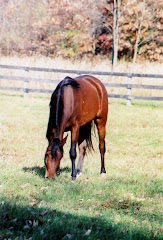Although we were never really positive about Tugboat's breeding, we always believed he was at least part Haflinger. The photo to the left was taken during his first two weeks at the horse center when we couldn't catch him. Seriously, once we unloaded him from the trailer and got him into his paddock, it took two weeks and five grown men to finally get a hold of him again.
You'll be able to read all about that when my book, The Tugboat Chronicles ~ Confessions of a School-Pony, is published. It's right there on page one.
Below are two photos of c
 urrent day Tugboat. First, you can see where he has calmed down quite a bit. A few years as a lesson pony, followed by getting his own human who takes him to shows, will calm anything worth calming.
urrent day Tugboat. First, you can see where he has calmed down quite a bit. A few years as a lesson pony, followed by getting his own human who takes him to shows, will calm anything worth calming.But if you look closely you can see his mane and tail, over time, have turned dark. No longer the light cream color that stood out so from his deep chestnut coat. In fact, he is beginning to look like a bay pony.
What does this mean as far as his breeding? Well it means he is certainly not 100% Haflinger because they are always chestnut with light mane and tail. But the fact that he is built the way he is, and his coloring, or his previous coloring,  suggests a Haflinger cross.
suggests a Haflinger cross.
 suggests a Haflinger cross.
suggests a Haflinger cross. The breed origin can be traced to medieval times when writings told of an Oriental breed of horse found in the Southern Tyrolean Mountains of what it now Austria and northern Italy. Many of the villages and farms in the Tyrol were accessible only by narrow paths requiring agile and surefooted horses for transportation and packing. Artwork from the region in the early 1800s depicts a noble chestnut horse with riders and packs traversing steep mountain trails.
During World War II there was a shift in breeding practices because the military needed a packhorse that was shorter and stockier. Consequently, the breed ended up as large ponies or small horses. Regardless of their size, characteristics of a Haflinger are a strong constitution, a solid conformation with substantial bone, and an uncomplicated personality.
Haflingers are considered "easy keepers," and can carry a lot more weight than other ponies or horses their size. Currently the American Haflinger Registry reports they are ridden in almost all disciplines, including dressage, western riding, driving, eventing, and especially trail riding.

+of+DallasGrazing.jpg)



No comments:
Post a Comment